|
|
A
History
of
the
Railways |
|
|
by Christopher J Tolley |
||
|
||||||
On The Main Line
The London and Southampton Railway
Just to show that history never stops, it has become necessary to add a preface to this page because Summer 1998 has seen the start of extensive redevelopment work in front of Basingstoke station, and so the original start to this history, and certainly the picture below of the Sailing by Stars sculpture surrounded by lavender no longer reflect the current reality. Instead, the area in front of the station is currently a building-site, and likely to remain so until the turn of the year. Once the work is complete, it is planned to return the sculpture to a location in front of the station. Now read on, as they say...
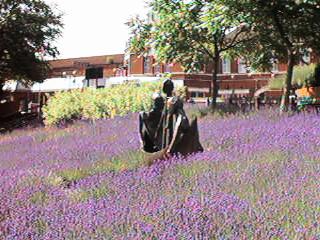
Sailing
by Stars,
a
sculpture
by Sarah
Tombs,
photographed
in July
1996, with
the
lavender
in bloom.
Basingstoke
station
is in the
background.
People who use or pass by Basingstoke station may well have noticed the sculpture in the garden in front of the station. This sculpture portrays several people in a boat and commemorates the use of the Basingstoke Canal to bring the building materials for the first railway to pass through Basingstoke. It was erected to mark the 150th anniversary of the opening of Basingstoke station. The Basingstoke canal is not the only waterway to feature in the history of Basingstoke's first line. Indeed, the creation of the first railway to come to Basingstoke can be indirectly attributed to a canal which was proposed but never built. Similarly, the choice of the route through Basingstoke may be attributed to a different railway which was proposed but never built.
Basingstoke's first railway was in its way the successor to an ambitious plan to link London and Spithead by a ship canal. In the 1820's, Britain had only recently defeated Napoleon Bonaparte, and relations with France were still unsettled, so a connection from the capital to the south coast would serve a military purpose, as well as being a highway. A leading civil engineer, John Rennie*, proposed the ship canal. A survey showed the canal would cost about £7,000,000. Whilst the colossal cost killed off the canal project, the survey suggested potential profit in constructing some kind of link even though at the time Hampshire did not have a large population. A group of businessmen began to investigate a railway link between Southampton and London. At a public meeting in April 1831, "the Southampton, London & Branch Railway & Dock Company" was established. Southampton was in those days very much smaller than Portsmouth, but was chosen in preference to its neighbour for its potential*. The harbour at Portsmouth was largely devoted to naval operations, so the fishing port of Southampton was more suitable for commercial development. As indicated by its name, the company was interested in the docks as well as the railway.
* “John Rennie”: a member of a family of civil engineers, Rennie (1761-1821) designed the former Waterloo, London and Southwark bridges over the Thames in London. He was also responsible for the Kennet and Avon Canal, among others, and many dock and harbour projects.
* “Southampton's potential”: In the time since this view was taken, Southampton did indeed grow as a centre for commercial shipping, becoming the home port of many famous liners, including the Queen Elizabeth 2, flagship of the Cunard company. The promoters of the line were obviously astute businessmen in more ways than one.
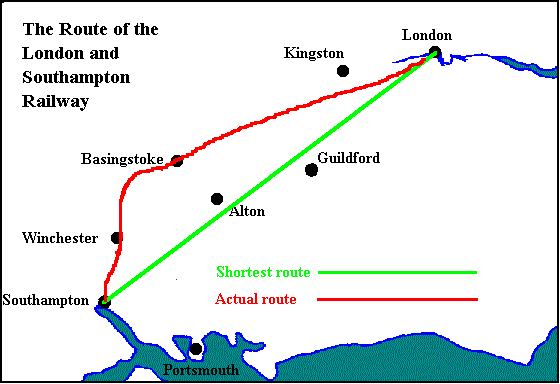
The map above shows the route projected by the railway. Not only did it avoid certain towns which could have been a source of revenue, such as Kingston, but the route was far from direct. Whilst hills and rivers usually dictate a railway's route to a certain extent, topography was not the main factor in determining the overall route of this line. The railway could have been more direct if the promoters had wished: the straight line route was more or less the route followed by the stagecoaches. These went by way of the Meon valley, Alton and Guildford. So why did the railway come to Basingstoke when towns such as Alton and Guildford could have been served by a more direct line? The answer lies in the company's name. The branch in the title of the company was a proposal to link Basingstoke with Bristol via Newbury and Devizes.
Other attempts were already under way to link Bristol with London, in the shape of the Great Western Railway. The promoters of the Southampton line may have been expecting opposition*, judging by the attempt to disguise their ambitions in that word, "branch." If the company's plans had come to fruition, the branch may well have become the main line. Bristol was then one of the largest cities outside London, and the branch would have been much longer than the southward continuation of the main line from Basingstoke. There were also several significant towns along the planned route to Bristol, compared with only Winchester on the main line. In the event, the promoters of the GWR were able to muster more support in Parliament than those of the Southampton scheme. The GWR was approved, and the Southampton line's wings were clipped. As a result, the company's name was amended to the London and Southampton Railway. Its Act received the Royal Assent on 25 July 1834.
* “opposition”: In fact, the managements in charge of the line from London to Southampton and the line from London to Bristol often came into conflict with each other as the railway system expanded. While the lines were being promoted, the circular reproduced below was issued in Basingstoke to warn about the ambitions of the other company. Its tone is instructive.
|
BASINGSTOKE , 10th August 1832 SIR, Some engineers and others are making great exertions to get a Railway established from Bristol to London, direct through Newbury, Reading and Maidenhead. I am sure you will readily perceive the ruinous consequences of the success of that undertaking to this Town and Neighbourhood, and how much it behoves us to avert it. All the advantages now derived from a great thoroughfare would be annihilated; Passengers and Goods of every description from the Westward would go by the Railway, and the Southampton Line would be compelled to alter its proposed direction, and go by Stockbridge and Andover to join the Bristol Railway at Newbury. The Canal Interest would be equally affected. It would lose the conveyance of all the Western Goods, and both it and Basingstoke would sink into a mere shadow to what they would otherwise be were the Southampton line continued as now proposed. Surely then, when the property of the Town and Neighbourhood is so seriously threatened, every exertion ought to be made to support the Southampton, London and Bristol Railway, which will not only secure our present advantages, but incalculably increase them. It is evident one of two lines will be accomplished. Not only the intercourse between London and Bristol, but between Ireland, Wales, Gloucestershire and all the Western Counties call for it: and a little energy on the part of this Town and neighbourhood, promptly applied, would give certainty to the success of the one which is favourable therein. According to the Plan of the Southampton and London Company, Basingstoke is the point of junction for the railway from Bristol and Southampton, to which, the one from Basingstoke to London will be a trunk, that is, receive the Carriages from both. A moment's reflection must show what an immense influx of Trade this would bring to our Town, the benefits of which would be extended to the Neighbourhood. What a vast quantity of heavy goods it would give to the Canal, and how much it would increase the value of property in the Town and Neighbourhood. A PUBLIC MEETING of the neighbouring Landowners and Inhabitants of this Town will therefore be held (by permission of the Mayor) at the Town Hall, on Wednesday the 29th instant, at 12 o'clock, to take the important subject into serious consideration. The line through Basingstoke has the recommendation of being without opposition, and the cheapest and most practicable, perhaps, of any line of equal extent in the Kingdom, while the upper line involves numerous obstacles and heavy expense. I
am,
Sir W. A. LEWIS
|
The engineer for the line was Francis Giles. Giles would have been familiar with the landscape in the area, as he had worked on the Basingstoke Canal. Whilst he was no doubt a fine surveyor, he did have a knack of backing the wrong horse, both in terms of criticising other civil engineers who usually proved themselves right at his expense, and in his approach to business. By 1837, mounting difficulties, many of which were his fault, led to his resignation. Giles's successor was Joseph Locke, and under his leadership the L&SR began to make real progress. Many contractors were used during the initial phases of construction of the line, but when Locke took over, he soon weeded out the less competent ones. He was astute enough to recognise the abilities of one of them - Thomas Brassey - and appointed him as contractor for most of the remaining work, including the Basingstoke to Winchester section.
The line was opened in four phases:
* “Nine Elms”: this was the original London terminus, 1½ miles further from Westminster than the current terminus at Waterloo, which was opened on 11 Jul 1848. In later years, a locomotive works and depot stood at Nine Elms. Today, the area is home to the New Covent Garden Market and its associated developments.
* “Woking Common”: renamed Woking at some stage, perhaps. This may be another example of the *Shapley Heath phenomenon - the mythical name. I'm not sure that these stations were ever called Woking Common or Shapley Heath, because none of the original materials I have consulted records those names.
* “Southampton”: the original terminus was not the station which is called Southampton, (or sometimes Southampton Central), today. It was much nearer the docks area, and survived in use until 5 Sep 1966.
The Winchester to Basingstoke section opened last because it was the most difficult to construct. With the exception of a short tunnel under the Basingstoke Canal near Farnborough, the only true tunnels* on the line were the four between Basingstoke and Winchester. This part of the line crossed the highest ground. The summit of the line is at Litchfield Tunnel, 400 feet higher than the ends of the line, which are both near sea level. The 1,100 navvies who built the section were responsible for the excavation with pick and shovel of some 3,250,000 cubic yards of earth and rock (mainly chalk). The work was continued day and night, and was completed to schedule.
* “tunnels”: today there are two extra tunnels between London and Southampton. The first is near Shawford, and results from the motorway crossing the line. The second is the tunnel under the centre of Southampton, but as noted above, this was not on the original route.
As it happened, there were also problems on the Basingstoke to Winchfield section. These took the form of landslides in the cutting sides. In the area between Hook and Winchfield, the railway is cut into geological strata known as the London Clay, the Bagshot Beds and the Bracklesham Beds. These consist of layers of sand, silt and clay which are quite friable, especially in certain weather conditions. The landslides affected not only the original construction of the line, but also the widening carried out at the start of the twentieth century. There have also been periodic landslides when no construction has been in progress. The most recent* landslide occurred in February 1995, leading to the closure of the down slow line for a week or so, while the slumped material was cleared away and the embankment shored up with cages filled with rocks.
* “most recent”: this was written in late 1995.
A tiled mural* at Winchfield station records the fact that it was the terminus of the line for a while. It also records various details of the early running of the line. On a recent visit to the station, I was told that it was a hive of activity in 1838-9. One of the larger nearby houses was used as a Post Office, and coaches would meet the trains as they arrived to take passengers on to their destinations.
* “mural”: designed by Susan Ferraby of the Winchfield Pottery, which occupies one of the buildings standing near to the station.
Although no mural at the station documents it, Basingstoke was also the terminus for a while. The first train to Basingstoke* was described as follows in the Hampshire Chronicle:
"On Monday the line of road from the Winchfield and Shapley Row station was opened to the public to the station at Basingstoke, a distance of eight miles - and, on the same day, from Southampton to Winchester, leaving only ten miles* to complete the undertaking. A party of directors and their friends left the terminus at Nine Elms, Vauxhall, at half past eleven and arrived at the Winchfield station at about five minutes to one, where a crowd of spectators was assembled and greeted them with hearty cheers. After a short delay, the train proceeded over the new ground to Basingstoke, while upon every height and at every place where a view could be obtained groups of anxious and admiring spectators were stationed to watch and applaud the progress of the engine and its bulky train upon its maiden excursion. At about half past two o'clock, the train started from Basingstoke on its return to Winchfield, accomplishing the distance without the slightest accident or annoyance to mar the pleasures of the day. A cold collation was provided at a cottage in the vicinity of the station, to which about sixty ladies and gentlemen sat down, including Mr. Easthope, M.P., the Chairman of the Company, Mr. T. Duncombe, M. P., Mr. Bainbridge, etc. At seven o'clock the party broke up and the train finally reached Vauxhall at ten past eight."
* “first train to Basingstoke”: One thing which makes this event especially noteworthy is that it marked the official opening of the line, even though the line was not fully built! This makes it difficult to follow different accounts which do not declare their dates. When reading about "opening day celebrations", one must distinguish between the official opening and the real opening, the following year.
* “ten miles”: it is hard to know what to make of this detail, because the true distance between Winchester and Basingstoke by rail is almost nineteen miles! I'll leave it to you - is it an accurate reflection of the outstanding work at this date, or did the original journalist get it wrong?
The opening throughout provoked another similar celebration, and the first train to run the entire 77 mile line took three hours to do it, arriving at Southampton to the sound of a twenty-one gun salute. The directors clearly liked their cold collations, another being provided for their celebration at Micheldever by Thomas Brassey. By this time, the L&SR had been given a new name, the London and South Western Railway. This arose from its plans to build a branch to serve Gosport. Apparently, the only reason the residents there had to object to the line was that the company was named after Southampton!
|
|
A
London
&
South
Western
Railway
land
boundary
post, |
One of the features of the L&SWR was the attention given to the architecture of the stations. The most noted architect employed on the line was Sir William Tite, who was certainly responsible for the termini of the line, and may also have designed the station which still stands at Micheldever*.
* “Micheldever”: If Tite did design this, and opinions vary on the matter, then he will have been responsible for the second station at Basingstoke as well, since this was virtually a twin of Micheldever. Whilst only photographs exist of Basingstoke, the station building at Micheldever is still intact. It is an elegant two-storey building, constructed of brick and well-dressed flints, and it retains a waist-level awning, despite not serving the platform since the station redevelopment during the 1990's.
Different authors have placed different emphasis on the highs and lows of the railway's operation. Professor H. P. White, in “A Regional History of the Railways of Great Britain: volume 2 - Southern England”, records that, "in 1846 the company had reputedly the fastest trains in the world with its 110-minute schedule to Southampton, 42.9 m.p.h. On one occasion, the Gooch* 2-2-2 'Elk'* did the up* journey in 93 minutes, 50.3 m.p.h." Meanwhile, R. W. Kidner, in “The Waterloo-Southampton Line”, mentions that, "the L&S quickly changed to engines of the 2-2-2 type, which would oscillate less on the track ... in 1843 J. V. Gooch took over; he ... began to dictate design," and then provides a list of locomotives omitting the star, Elk, and making no reference to the world-beating speed. Elsewhere in the same book, he mentions an 1839 average speed of 31.57 m.p.h., the fact that a cutting south of Winchester breached some tenth century plague pits and details some early accidents.
* “Gooch”: this was John Viret Gooch, not his more illustrious brother Daniel, who built locomotives for the GWR. John V. Gooch was appointed Locomotive Superintendent in 1841 and established the locomotive works at Nine Elms in 1843.
* “Elk”: this locomotive was not built at Nine Elms, but by Fairburn & Co., to Gooch's design.
* “up”: in railway terms, the up line is the one going towards the more important place, in this case, London.
Differing emphases aside, it is undeniable that the L&SWR was a success, and was popular with those who used it. Even when it was only open as far as Winchfield, people were already changing their journeys so that their coach connected with the train. Indeed, the time savings offered by the railway, as well as the increased reliability, made it well worth doing so. Apparently, even Queen Victoria was pleased with the railway when she used it: Farnborough was, according to one source, used as a railhead for Windsor until that town acquired its own stations.
The L&SWR soon started expanding*. A new terminus was provided at Waterloo in 1848. This has been rebuilt twice since - first during the early years of this century, and again during the past few years to accommodate the international service to Paris and Brussels. At the Southampton end of the line, a new station called Blechynden was opened on 1 June 1847, near to the site of the current Southampton station. At first, it formed the eastern terminus of a service from Brockenhurst, but within two months it had been connected via a tunnel to the Southampton Terminus station. After a curve had been constructed in 1858 giving direct access to the London direction, it was renamed Southampton West. This station was rebuilt in 1895 on the current site, and then renamed Southampton Central (though as noted above, the "Central" is more or less optional.) Diversion through Blechynden meant that the line could be extended westwards along the coastal plain, and this happened in due course, with through running to Christchurch and Bournemouth in 1888 and all the way to Weymouth* in 1893.
* “expanding”: for details of the local expansions, consult the relevant sections in this history. Other expansions are largely beyond the scope of this history, and only mentioned in passing where they directly affect the local area.
* “ Weymouth ”: the development was complicated by the rise of Bournemouth well after the start of the railways. I have simplified it here, as it is beyond my scope.

The
eastern
approach
to
Basingstoke
station,
12 March
1998.
The
platforms
are
numbered 1
to 5 from
left to
right in
the
picture.
A class 73
locomotive
stands at
platform
4, while a
class 165
diesel
unit
occupies
the bay
platform
5. The
tracks
entering
the
picture
from the
right hand
edge
join up
with the Reading
route.
The track
at the
left edge
of the
picture is
a siding.
Thanks to a major rebuilding programme along the line at and shortly after the turn of the 20th century, the line from Basingstoke to Waterloo is at least four-track throughout, with up to eight tracks between Clapham Junction and Waterloo. The signs of this rebuilding are obvious at all the local stations. South of Basingstoke, a new flyover* was provided at Battledown, to take the northbound Winchester line track over both the tracks on the line to Whitchurch and Salisbury. At Basingstoke, a new station was built, to replace the 1851 version*, which only had two tracks. The bridge carrying the Reading Road over the tracks had originally spanned two tracks, and was made of brick: this was replaced with the current wider steel bridge in 1899. At Hook and Winchfield, the canopies of the platform shelters are different on each outer track - the up (original) platform has a curved canopy and the down one an angled canopy. At each of these stations, a central platform was also provided, but these have since been removed. As to the railway technology, the speed of the early locomotives has already been noted, but the L&SWR was at the forefront of other technologies as well. The L&SWR was one of the first companies to recognise the virtue of signals*. Among the earliest designs tried by the L&SWR was the half-moon* style. In later years, the L&SWR used signals near Basingstoke, which were operated by compressed air, and which were automatically set and reset by the passage of trains. This is the principle behind the modern colour-light signalling employed throughout the railway network.
* “flyover”: Several similar flyovers were constructed along the route at the same time, but surprisingly one was not provided at Woking, where the flat junction remains a potential source of delays.
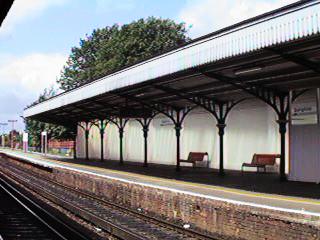
* “to replace the 1851 version”: the 1851 date is an estimate on my part, as I note from John Fairman's account, among others, that there was a new station "by 1851". In fact, part of this station survives. On the current platform 4, at the Winchester end of the station is an awning which slopes upwards towards the platform edge. This marks the oldest part of the current station - shown in the photograph above, taken in June 1996.
* “signals”: Early railways ran infrequent, slow services, and often had no signals. As accidents began to occur, the railways first used policemen guarding the sections of the line, and then began to install signals to provide a visual indication at a greater distance, which was becoming more important as speeds increased.
|
1. |
2. |
3. |
|
* “half-moon signals”: These controlled two tracks. They were circular with a semicircle cut out of them, and could be rotated so that the drivers could not see them, to represent "up and down lines clear". When rotated face-on to the driver of an up train, the following indications were provided - illustrated above: 1. up line clear, down line blocked 2. down line clear, up line blocked 3. both lines blocked |
||
Third-rail electrification was another area in which the L&SWR was an innovator, and after the 1923 Grouping, the electric network spread rapidly under the leadership of the enthusiastic General Manager, Sir Herbert Walker, though it only reached Basingstoke during the 1960's.
Basingstoke could have been the home to the L&SWR's railway works. By the late 1860's, Nine Elms was becoming increasingly cramped and unsuitable as a location for the works. The L&SWR approached the Town Council at Basingstoke, with a proposal to build a replacement works on the south side of the line, going towards Winchester. In the event, the Council refused. Ironically, in 1898, an engineering works was built on the site the L&SWR had requested - Thornycroft's*. As a result, the L&SWR settled at Eastleigh, and the employment and civic development which the works would have engendered went to Eastleigh as well.
* “Thornycroft's”: There was indeed irony in this. The motor company had also moved out from London (Chiswick, in fact) when their premises there became too cramped. To compound the irony, a rail connection was made to the site soon afterwards. In terms of employment opportunities, the railway would have been better for Basingstoke, as Thornycroft's has long gone, while railway work continues at Eastleigh
The rest of the story of the line from London to Southampton is one of steady progress. Trains became faster as time went by, as shown on the graph below. (The post-war slowing was due to the run-down state of the locomotives and stock - not only had the railways carried more passengers and freight with reduced maintenance, but they were a target for enemy bombers as well.)
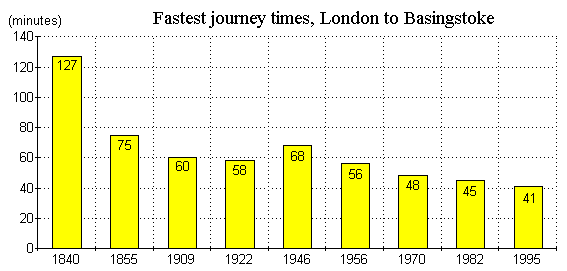
Although the line from London through Basingstoke has had its share of technological firsts, it was among the last on British Rail to be worked by steam. Officially, this method of operation came to an end on 2 July 1967. The steam locomotive-hauled trains were replaced by electric multiple-unit trains. At first, the section between Bournemouth and Weymouth was not electrified, so that a diesel locomotive took the trains on to Weymouth. This section was electrified in 1988, and now electric trains run through.
One event in particular on the line in the last few years has marred the overall success story. That was the accident at Clapham Junction on 12 December, 1988. This involved one train which had started from Basingstoke, and another which had called at Basingstoke to pick up passengers on its way from Poole. 35 people died as a result of that accident, and almost 500 others were injured. This was by far the most serious accident to occur on the line in its century and a half of operation. The cause was found to be the faulty installation of a new signalling circuit, which fooled the driver of the second train into thinking that the track ahead of his train was clear, when in fact the next section* contained a stationary train. Aside from this, there have been very few other serious accidents on the former London and Southampton route.
* “section”: in railway terms, a section is the length of track between two successive signals.
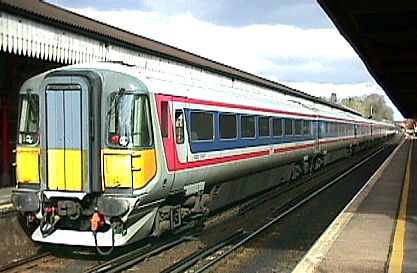
Class
442
electric
multiple-unit
trains are
the
mainstay
of the
express
services
from
London
through
Basingstoke
to
Southampton,
Bournemouth
and Weymouth.
Here is
one at Winchester
on 28
February
1998.
Click here to return to the table of contents for Basingstoke's Railway History
|
This
article
is
a
part
of
the
Basingstoke
&
District
Railway
Society
website. |